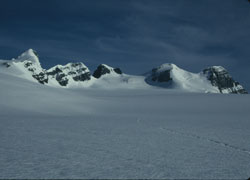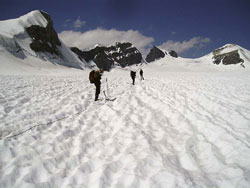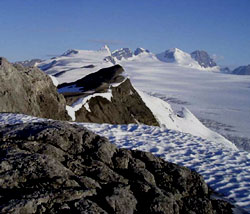
Photo: The peaks of Mount Lyell (l-r) Christian Peak, Walter Peak, Ernest Peak, Edward Peak, and Rudolph Peak from the southeast (courtesy Rienk Lakeman)
Mount Lyell
- 3511 m (11,520ft)
- First Ascent
- Naming History
Located on the continental divide at the head of Arctomy's Creek Valley and the head of Lyell Creek
Province: Alberta/BC
Park: Banff
Headwater: Saskatchewan/Columbia
Ascent Party: James Outram
Ascent Guide: Christian Kaufmann
Named by: James Hector
Named for: Lyell, Sir Charles (A noted British geologist, Sir Charles Lyell studied fossils in Britain, Europe, and North America.)
There are five peaks in the Lyell group that rise in a semi-circle above the Lyell Icefield. Although the summits are relatively high in elevation, the peaks present only a modest rise above the surrounding glaciers." -courtesy Chic Scott In this database there are similar entries for Mount Lyell and Ernest Peak which is the highest point of the Mount Lyell massif (3511 metres) on the Continental Divide. Edward Peak is reported to be 3514 metres and is entirely in Alberta. The five peaks of Mount Lyell were named, at the suggestion of Sydney Vallance, after prominent mountaineering guides originally brought to Canada by the CPR and who became residents of Canada. The five were Edward Feuz jr, Ernest Feuz, andWalter Feuz, Rudolph Aemmer, and Christian Hasler jr and they took up permanent residence in Golden in 1912. They are part of what was called the "Swiss Guide Group." The five peaks form an arc which opens to the east on the Alberta side of the Lyell Icefield, Ernest Peak being at the centre. Rudolph Peak is at the northeast end of the arc with Edward Peak lying midway between Ernest Peak and Rudolph Peak. Rudolph Peak and Edward Peak are not on the Continental Divide. The other three peaks are. The southeast end of the arc is Christian Peak with Walter Peak lying between Christian Peak and Ernest Peak. Ernest Peak, Edward Peak, and Rudolph Peak are all of comparable height (3507 metres) while Walter has an elevation of 3400 metres and Christian an elevation of 3368 metres. Following his 1926 expedition to the area, Alfred J. Ostheimer< wrote, "Like five fingers, the peaks of Lyell jut from the icefield, Number One stands out to the east in a great block, Number Two is a tremendous snow mass, flanked on the east by great ice cliffs, Number Three is isolated and sheer, protected on all sides by a gigantic overhang -rock and ice both tower forbidingly, Number Four seems a long rock ridge, while Number Five hides its northern drop behind a gentle southern snow slope." Sir Charles Lyell (1797-1875) was a geologist whose work helped to form the basis of geology and geologic time and played a role in establishing geology as a separate science. His book, Principles of Geology, (1830) developed the theory of uniformitarianism, that the Earth's history can be explained by gradual change over time. He also suggested that different periods of geologic time could be established by reference fossils. He divided geologic time into four periods; Pleistoscene, Older Pliocene, Miocene and Eocene. He also explained how one type of rock was transformed into another, and developed theories related to volcanic forces, deposition and erosion.





